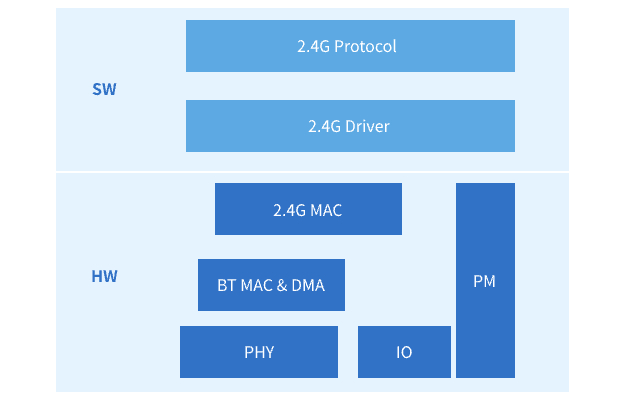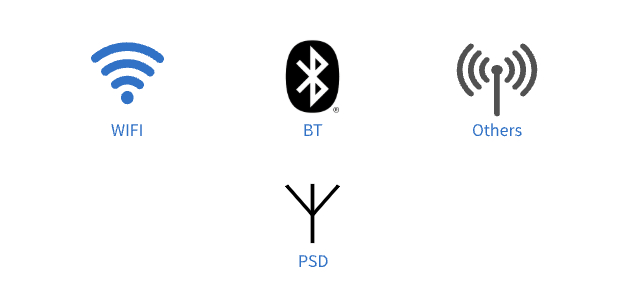

Compact, flexible, efficient, and comprehensive. Everything is under control.
The 2.4GHz frequency band is a free ISM band, which operates on various standard protocols (such as Wi-Fi, Bluetooth, Zigbee) as well as various proprietary protocols.
Proprietary protocols utilize Radio's TRX, PSD, and other functions to achieve signaling control and data transmission of MAC layer protocols, providing private wireless communication services for upper layers. Customers can choose to develop their own private protocols or directly use the private protocols we provide, such as HID.
Characteristic:
- Simplicity and flexibility: Private protocols can be customized according to specific needs to avoid redundancy and compatibility issues that may exist with standard protocols, achieving a "small but refined" effect.
- Performance optimization: For specific application scenarios, private protocols can break through standard limitations and achieve ultimate performance optimization. For example, by compressing message length and shortening RF transmission time, HID gaming devices can meet their demand for high reporting rates.
- Rapid prototyping and differentiation: Private protocols can help users quickly implement innovative ideas, master core technologies, enhance product uniqueness and competitive advantages.
Application Scenario

HID products implemented through private protocols can achieve lower latency, higher reporting rates, and better sound quality, providing users with a better experience.

Through private protocols, thousands of electronic tags can be managed, resulting in lower power consumption and longer lifespan, providing support for smart retail.

HID products implemented through private protocols can achieve lower latency, higher reporting rates, and better sound quality, providing users with a better experience.

Through private protocols, thousands of electronic tags can be managed, resulting in lower power consumption and longer lifespan, providing support for smart retail.
Basic Working Principle
The function of a private protocol is jointly implemented by software and hardware modules. The hardware includes MAC, PHY, IO, and Power Manager. 2.4G MAC will reuse some functions of BT MAC and use the same PHY as BT MAC. The software includes Driver and Protocol. Driver will provide basic functions such as register access and initialization. Protocol is a specific implementation of a private protocol, which has different ways of using lower level drivers and hardware in different private protocols, such as configuring different frame formats.


The frame structure supported by the private protocol Radio module consists of the following five parts: preamble, access address, header, payload, and CRC.
- Preamble: The length can be configured, and the content of each byte is the same when multiple bytes are used.
- Access Address: Used for device filtering, with configurable length and content.
- Header: It contains three fields: Header Initialize, Length, and Header Suffix, and the length and content of each field can be independently configured.
- Payload: Variable length, specified by the Length field in the header.
- CRC: Frame checksum field, which includes the header and payload. CRC supports configuring length, generating polynomials, and initial values.
The two devices, which are in the Proprietary Tx (PTX) and Proprietary Rx (PRX) states respectively, play the roles of both ends of point-to-point 2.4G communication: the PRX state device acts as a passive listener waiting for PTX to send, while the PTX state device acts as an active sender, sending the request message first. PRX can choose whether to send a response message after hearing it. Therefore, both ends can perform one-way communication from PTX to PRX, as well as two-way communication between the two. Based on this, one to many and even more complex scenarios can be expanded.


There are various types of wireless interference in the environment, and private protocols can use frequency hopping technology to combat interference. Utilizing the environmental interference detection PSD function to collect channel interference strength, evaluate and screen out available channel sets, and provide them to frequency hopping algorithms for effective interference avoidance and improved reliability of private protocols.
Specification Parameters

- Adjustable frame structure, PHY rate, frequency, CRC, and whitening configuration
- Support PTX modes: oneshot, periodic
- Support PRX modes: oneshot, continuous
- Supports interference detection
- Supports one-to-many communication

- Low latency
- High report rate
- Supports frequency hopping for anti-interference
- Supports retransmission
- Supports RF test mode
Advantages

The diverse functions provide strong support for the design and implementation of private protocols.

Outstanding RF performance enables proprietary protocols to break through the limitations of traditional protocols, achieving exceptional performance.

The rich SoC resources help accelerate the development and deployment of applications based on proprietary protocols.
Product Applications


Implementation Guide
Determine the communication requirements of the application scenario, including interaction methods, data length, communication frequency, etc.
Determine the frame format, communication frequency, timing requirements, and other parameters of the private protocol based on application needs. Ensure that the 2.4G Radio specifications meet application requirements. Alternatively, existing standard protocols can be directly used.
Conduct a comprehensive evaluation of the implementation of proprietary protocols and the application of other functional implementations to select the appropriate IC platform.
Develop and test various functions of the protocol according to the private protocol specifications, and deliver them for use by upper-layer applications.
Recommended Hardware
Part Number | RTL8762GKH | RTL8752H |
|---|---|---|
CPU | CM55 125MHz | CM0+ 40MHz |
FLASH | 1MB | Maximum 1MB |
RAM | 384KB | 120KB |
Tx Power | Up to 4 dBm | Up to 7.5 dBm |
Rx Sensitivity | -98 dBm @ BLE 1M | -98 dBm @ BLE 1M |
Tx Power Consumption (0 dBm) | 6.9 mA | 5.4 mA |
Rx Power Consumption | 5.6 mA | 5.3 mA |
USB | USB2.0 HS Device | N/A |
Provided Protocol | HID/DTM | DTM |
Reference Doc |



 苏公网安备32059002006558号
苏公网安备32059002006558号